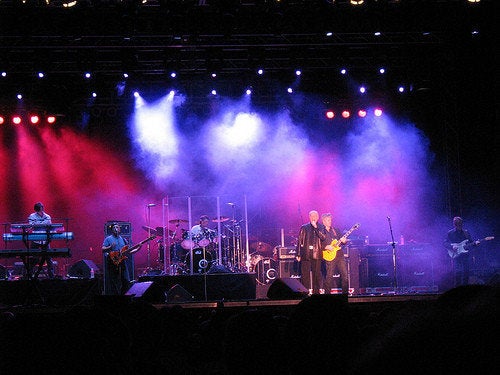
Is loud music the new smog? Have woofers and tweeters replaced tailpipes as the irritant de jour, spewing clouds of nasty noise into once-tranquil environments?
The press seems to think so. Recently, several reporters and columnists have described the difficulty of engaging in civilized conversation while dining at their local eateries. Trendy restaurants now seem to value high-decibel background music over customer repartee. A desirable ambience is no longer defined by low lighting, appealing décor, or deferential waiters. Sound pressure levels are everything.
I haven't personally felt the onslaught of this dining din. But I am puzzled by another source of noise that's so extreme, I suspect it violates the Geneva Conventions: rock bands.
The fact that live rock is louder than a two-dollar tie probably doesn't surprise you, at least if you've heard any in the last half-century. The trouble started 65 years ago when Leo Fender sold the first commercial electronic guitar amplifier. Mind you, Fender's intentions were honorable: guitars had been largely shut out of instrument ensembles because they're naturally soft. In a musical group, guitar players were merely decorative. With an electronic boost, they could be heard.
In short order, they could also be felt, as the amplifiers bulked up. In 1969, Led Zeppelin became famous for being fortissimo, reaching sound levels of 130 decibels during concerts. This is the same loudness as a pneumatic rock drill, in case you've experienced one of those. It's about a thousand times louder than a lawn mower or a boiler factory.
Who would have thought that was a good thing? Well, other rock groups did, consumed as they were by decibel envy. Deep Purple's audio onslaughts are said to have knocked audience members unconscious, and in 2009, a performance by KISS peaked at 137 decibels (five times the power of Led Zeppelin).
The hardware that makes these vast volumes possible kept ramping up too, leaving Fender's original product in the vibrating dust. A modern bass amplifier, the Super SVT made by Ampeg, deploys 36 ten-inch speakers, and runs at 600 watts. That's close to a horsepower of acoustic gusto.
Frankly, this rip-roaring rock's too much for me. Attending a science conference recently, I was invited to an evening event featuring a talented three-piece band. At least, I think they were talented. The wall of sound was so crushing, it rattled the pimentos out of the olive hors d'oeuvres. So who knows if the music was any good.
Distraught by this experience, I asked one of my colleagues -- a band member himself -- if all of today's groups played at such earth-shattering volume. His answer was quick and unambiguous: "Yes," he said. When I protested that such raucous performances were unpleasant and uncomfortable, he suggested that my problem was simply age. I was too old for the modern music genre.
That was a low blow. The problem couldn't be me, could it? I interrogated a dozen summer students doing research at the institute where I work. Average age: twenty years.
"How many of you like partying to music that's louder than the roar of 150 ticked-off lions?" I asked. (That, by the way, is the KISS concert level.) To my surprise and chagrin, three-quarters of the students answered in the affirmative. They volunteered that there was something visceral about gyrating to noise so loud, it could shake loose bricks.
Young folks seem to like a lot of things -- like cheap noodles and texting while cycling -- that diminish in appeal once you're old enough to feel your own mortality. Loud music may be just another item on this list. But there's more to this phenomenon than merely an odd penchant for tumult. Loud rock takes a toll, if not aesthetically, then physiologically. It will slowly deafen you, as repeated loud music subjects the inner ear to major mechanical stress.
It's a danger our bodies are not engineered to handle. For two hundred thousand years, the loudest noise that Homo sapiens suffered were thunderclaps. But these weigh in at about 120 decibels, dozens of times less energetic than a modern rock band. And they are highly intermittent.
Arthur Popper, a neuroscience professor at the University of Maryland, explained it to me this way:
If someone punches you in the arm, you might wince. But it's not a long-term problem. However, if they punch you for hours at a time, several times a month, the damage becomes long-term.
Repeated exposure is the problem, Popper notes. Loud bands, as well as high volume in earphones and ear buds, are killing our hearing.
Look, I don't want to rain on anyone's parade, nor come off sounding like the food police who warn that eating kung pao chicken will make your liver explode. But a recent study by researchers at Brigham and Women's Hospital in Boston showed that the fraction of teens with hearing loss grew from 15 percent in 1994 to 20 percent in 2006. It's happening.
This is not only literally and figuratively disquieting, it's also ironic. Early guitars, unimposing instruments that date to the time of Columbus, produced a sweet but wimpy sound. But thanks to a truck-load of amplification, their descendants have become the bullies on the beach, able to deafen a generation.
I'm willing to accept that my aversion to amped-up rock is just another weird thing about getting older. But the down side to music able to knock band fans unconscious is real and widespread. So I wonder, is anybody listening?
It's something you might think about the next time you torture-test the welds in your car with those custom woofers and monster amps. Assuming you can still hear yourself think.